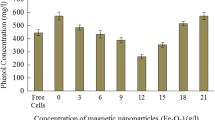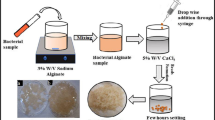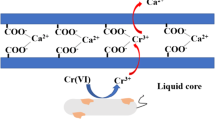Abstract
Recently isolated Cr(VI)-reducing Amphibacillus KSUCr3 whole cells were immobilised in magnetic gels. Magnetic magnetite (Fe3O4) nanoparticles were synthesised with an average particle size of 47 nm and 80 electromagnetic unit (emu)/g saturation magnetisation. Whole cells were immobilised by entrapment in agar, agarose, alginate, or gelatin in the presence or absence of Fe3O4 nanoparticles for the preparation of both magnetic and nonmagnetic immobilised cells. Of the gels tested, alginate was selected as the best immobilisation matrix, and following optimisation of the entrapment process, the immobilisation yield reached 92.5%. In addition to the ease of separation and reuse of the magnetic cell-containing alginate beads using an external magnet, the magnetically immobilised cells showed approximately 16% higher Cr(VI) reduction activity compared with nonmagnetic immobilised cells. To improve their physical and mechanical properties, the magnetic alginate beads were successfully coated with a dense silica layer using sol-gel chemistry and Ca(OH)2, an alkaline catalyst for tetraethyl orthosilicate, to avoid leaching of Ca2+ ions. Amphibacillus KSUCr3 cells immobilised in silica-coated magnetic alginate beads showed approximately 1.4- to 3.9-fold enhancement of thermal stability compared with free cells. Furthermore, after seven batch cycles, the Cr(VI) reduction activity of free cells decreased to 48%, whereas immobilised cells still retained 81.1% of their original activity. In addition, the Cr(VI)-reduction rate of immobilised cells was higher relative to free cells, especially at higher Cr(VI) concentrations. These results supported the development of a novel, efficient biocatalysts for Cr(VI) detoxification using a combination of whole cell immobilisation, sol-gel chemistry, and nanotechnology.
Similar content being viewed by others
References
Sarangi, A. and C. Krishnan (2008) Comparison of in vitro Cr(VI) reduction by CFEs of chromate resistant bacteria isolated from chromate contaminated soil. Bioresour. Technol. 99: 4130–4137.
Mclean, J. and T. J. Beveridge (2001) Chromate reduction by a Pseudomonad isolated from a site contaminated with chromated copper arsenate. Appl. Environ. Microbiol. 67: 1076–1084.
Cefalu, W. T. and B. H. Frank (2004) Role of chromium in human health and in diabetes. Diabetes Care 27: 2741–2751.
Cheung, K. H., H. Y. Lai, and J. D. Gu (2006) Membrane-associated hexavalent chromium reductase of Bacillusmegaterium TKW3 with induced expression. J. Microbiol. Biotechnol. 16: 855–862.
Opperman, D. J., L. A. Piater, and E. Van Heerden (2008) A novel chromate reductase from Thermusscotoductus SA-01 related to old yellow enzyme. J. Bacteriol. 190: 3076–3082.
Focardi, S., M. Pepi, G. Landi, S. Gasperini, M. Ruta, P. Biasio, and S. E. Focardi (2012) Hexavalent chromium reduction by whole cells and cell free extract of the moderate halophilic bacterial strain Halomonas sp. TA-04. Inter. Biodeter. Biodegrad. 66: 63–70.
Sau, G. B., S. Chatterjee, and S. K. Mukherjee (2010) Chromate reduction by cell-free extract of Bacillusfirmus KUCr1. Pol. J. Microbiol. 59: 185–190.
He, M., X. Li, H. Liu, S. J. Miller, G. Wang, and C. Rensing (2011) Characterization and genomic analysis of a highly chromate resistant and reducing bacterial strain Lysinibacillusfusiformis ZC1. J. Hazard. Mater. 185: 682–688.
Ozturk, S., B. Aslim, and Z. Suludere (2009) Evaluation of chromium( VI) removal behaviour by two isolates of Synechocystis sp. in terms of exopolysaccharide (EPS) production and monomer composition. Bioresour. Technol. 100: 5588–5593.
Xu, L. X., M. Luo, C. Jiang, X. Wei, P. Kong, X. Liang, J. Zhao, L. Yang, and H. Liu (2012) In vitro reduction of hexavalent chromium by cytoplasmic fractions of Pannonibacterphragmitetus LSSE-09 under aerobic and anaerobic conditions. Appl. Biochem. Biotech. 166: 933–941.
Camargo, F. A., B. C. Okeke, F. M. Bento, and W. T. Frankenberger (2003) In vitro reduction of hexavalent chromium by a cell free extract of Bacillus sp., ES 29 stimulated by Cu2+. Appl. Environ. Microbiol. 62: 569–573.
Zahoor, A. and A. Rehman (2009) Isolation of Cr(VI) reducing bacteria from industrial effluents and their potential use in bioremediation of chromium containing wastewater. J. Environ. Sci. 21: 814–820.
Martorell, M. M., P. M. Fernández, J. I. Fariña, and L. C. Figueroa (2012) Cr(VI) reduction by cell-free extracts of Pichiajadinii and Pichiaanomala isolated from textile-dye factory effluents. Inter. Biodeter. Biodegrad. 71: 80–85.
Dey, S. and A. K. Paul (2012) Optimization of cultural conditions for growth associated chromate reduction by Arthrobacter sp. SUK 1201 isolated from chromite mine overburden. J. Hazard. Mater. 213–214: 200–206.
Kathiravan, M. N., R. K. Rani, R. Karthick, and K. Muthukumar (2010) Mass transfer studies on the reduction of Cr(VI) using calcium alginate immobilized Bacillus sp. in packed bed reactor. Bioresour. Technol. 101: 853–858.
Pang, Y., G. Zeng, L. Tang, Y. Zhang, Y. Liu, X. Lei, M. Wu, Z. Li, and C. Liu (2011) Cr(VI) reduction by Pseudomonas aeruginosa immobilized in a polyvinyl alcohol/sodium alginate matrix containing multi-walled carbon nanotubes. Bioresour. Technol. 102: 10733–10736.
Shih, I., L. Chen, and J. Wu (2010) Levan production using Bacillus subtilis natto cells immobilized on alginate. Carbohyd. Polym. 82: 111–117.
Sreenivasulu, C., M. Megharaj, K. Venkateswarlu, and R. Naidu (2012) Degradation of p nitrophenol by immobilized cells of Bacillus sp. isolated from soil. Inter. Biodeter. Biodegrad. 68: 24–27.
Samuel, J., M. Pulimi, M. L. Paul, A. Maurya, N. Chandrasekaran, and A. Mukherjee (2013) Batch and continuous flow studies of adsorptive removal of Cr(VI) by adapted bacterial consortia immobilized in alginate beads. Bioresour. Technol. 128: 423–430.
Chen, J. and Y. Lin (2007) Decolorization of azo dye by immobilized Pseudomonas luteola entrapped in alginate-silicate solgel beads. Proc. Biochem. 42: 934–942.
Vikartovska, A., M. Bucko, D. Mislovicova, V. Patoprsty, I. Lacik, and P. Gemeiner (2007) Improvement of the stability of glucose oxidase via encapsulation in sodium alginate-cellulose sulfate-poly(methylene-co-guanidine) capsules. Enz. Microb. Technol. 41: 748–755.
Wang, X., Z. Gai, B. Yu, J. Feng, C. Xu, Y. Yuan, Z. Lin, and P. Xu (2007) Degradation of carbazole by microbial cells immobilized in magnetic gellan gum gel beads. Appl. Environ. Microbiol. 73: 6421–6428.
Gangadharan, D., K. M. Nampoothiri, S. Sivaramakrishnan, and A. Pandey (2009) Immobilized bacterial α-amylase for effective hydrolysis of raw and soluble starch. Food Res. Inter. 42: 436–442.
Ortega, N., M. Perez-Mateos, M. C. Pilar, and M. D. Busto (2009) Neutrase immobilization on alginate-glutaraldehyde beads by covalent attachment. J. Agric. Food Chem. 57: 109–115.
Lim, S. Y., K. Kim, D. Kim, and C. Park (2009) Silica-coated alginate beads for in vitro protein synthesis via transcription/translation machinery encapsulation. J. Biotechnol. 143: 183–189.
Deng, H., X. Li, Q. Peng, X. Wang, J. Chen, and Y. Li (2005) Monodisperse magnetic single crystal ferrite microspheres. Angew Chem. Int. Ed. 44: 2782–2785.
Ibrahim, A. S., M. A. El-Tayeb, Y. B. Elbadawi, A. A. Al-Salamah, and G. Antranikian (2012) Hexavalent chromate reduction by alkaliphilic Amphibacillus sp. KSUCr3 is mediated by cupper dependent membrane-associated Cr (VI) reductases. Extremoph. 16: 659–668.
Ibrahim, A. S., M. A. El-Tayeb, Y. B. Elbadawi, and A. A. Al- Salamah (2011) Isolation and characterization of novel potent Cr (VI) reducing alkaliphilic Amphibacillus sp. strain KSUCr3 from hypersaline soda lakes. Electronic J. Biotechnnol. 14(4): 1–14.
Woodward, J. (1988) Methods of immobilization of microbial cells. J. Microb. Methods 8: 91–102.
Vujcić, Z., Z. Miloradovic, A. Milovanovic, and N. Bozic (2011) Cell wall invertase immobilisation within gelatin gel. Food Chem. 126: 236–240.
Pal, A., S. Dutta, and A. K. Paul (2005) Reduction of hexavalent chromium by cell free extract of Bacillus sphaericus AND 303 isolated from serpentine soil. Curr. Microbiol. 51: 327–330.
Bartlett, R. J. and B. R. James (1996) Chromium. pp: 683–701. In: Sparks, D. L. (eds.), Methods of soil Analysis. SSSA, Madison, WI.
Gong, J., S. Li, D. Zhang, X. Zhang, C. Liu, and Z. Tong (2010) High quality self-assembly magnetite (Fe3O4) chain-like coreshell nanowires with luminescence synthesized by a facile onepothydrothermal process. Chem. Commun. 46: 3514–3516.
Guo, X., Y. Deng, D. Gu, R. Che, and D. Zhao (2009) Synthesis and microwave absorption of uniform hematite nanoparticles and their core-shell mesoporous silica nanocomposites. J. Mater. Chem. 19: 6706–6712.
Lee, K. Y. and D. J. Mooney (2012) Alginate: Properties and biomedical applications. Prog. Polym. Sci. 37: 106–126.
Elangovan, R., L. Philip, and K. Chandraraj (2010) Hexavalent chromium reduction by free and immobilized cell-free extract of Arthrobacter rhombi-RE. Appl. Biochem. Biotechnol. 160: 81–97.
Tapingkae, W., K. L. Parkin, S. Tanasupawat, J. Kruenate, S. Benjakul, and W. Visessanguan (2010) Whole cell immobilisation of Natrinemagari BCC 24369 for histamine degradation. Food Chem. 120: 842–849.
Cheirsilp, B., B. Jeamjounkhaw, and A. H. Kittikun (2009) Optimizing an alginate immobilized lipase for monoacylglycerol production by the glycerolysis reaction. J. Mol. Catal. B: Enz. 59: 206–211.
Robatjazi, S. M., S. A. Shojaosadati, R. Khalilzadeh, E. V. Farahani, and N. Balochi (2012) Immobilization of magnetic modified Flavobacterium ATCC 27551 using magnetic field and evaluation of the enzyme stability of immobilized bacteria. Bioresour. Technol. 104: 6–11.
Zhang, W. (2003) Nanoscale iron particles for environmental remediation: An overview. J. Nanopart. Res. 5: 323–332.
Kanel, S. R., B. Manning, L. Charlet, and H. Choi (2003) Removal of Arsenic(III) from Groundwater by nanoscale zerovalent iron. Environ. Sci. Technol. 39: 1291–1298.
Ponder, S. M., J. G. Darab, and T. E. Mallouk (2000) Remediation of Cr(VI) and Pb(II) aqueous solutions using supported nanoscale zero-valent iron. Environ. Sci. Technol. 34: 2564–2569.
Ping, W., F. Xuerong, C. Li, W. Qiang, and Z. Aihui (2008) Decolorization of reactive dyes by laccase immobilized in alginate/gelatinblent with PEG. J. Environ. Sci. 20: 1519–1522.
Zhou, Z., G. Li, and Y. Li (2010) Immobilization of Saccharomyces cerevisiae alcohol dehydrogenase on hybrid alginate-chitosan beads. Inter. J. Biolog. Macromol. 47: 21–26.
Coradin, T., N. Nassif, and J. Livage (2003) Silica-alginate composites for microencapsulation. J. Appl. Microbiol. Biotechnol. 61: 429–434.
Ichiura, H., T. Konishi, and M. Morikawa (2009) Alginate film prepared on polyethylene nonwoven sheet and its function for ellagic acid release in response to sodium ions. J. Mater. Sci. 44: 992–997.
Myneni, S. B., S. J. Traina, G. A. Waychunas, and T. J. Logan (1998) Vibrational spectroscopy of functional group chemistry and arsenate coordination in ettringite. Geochim. Osmochim. Acta 62: 3499–3514.
Zhu, S., D. Zhang, Z. Chenb, and Y. Zhang (2009) Controlled synthesis of core/shell magnetic iron oxide/carbon systems via a self-template method. J. Mater. Chem. 19: 7710–7715.
Author information
Authors and Affiliations
Corresponding author
Rights and permissions
About this article
Cite this article
Ibrahim, A.S.S., Al-Salamah, A.A., El-Toni, A.M. et al. Detoxification of hexavalent chromate by Amphibacillus sp. KSUCr3 cells immobilised in silica-coated magnetic alginate beads. Biotechnol Bioproc E 18, 1238–1249 (2013). https://doi.org/10.1007/s12257-013-0373-6
Received:
Revised:
Accepted:
Published:
Issue Date:
DOI: https://doi.org/10.1007/s12257-013-0373-6




